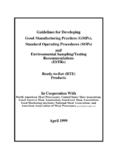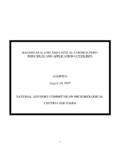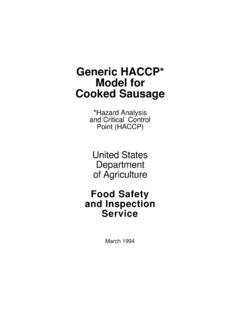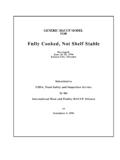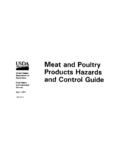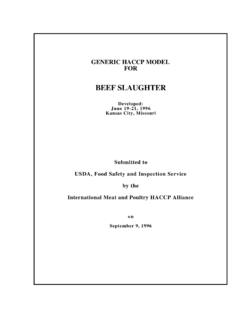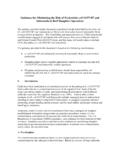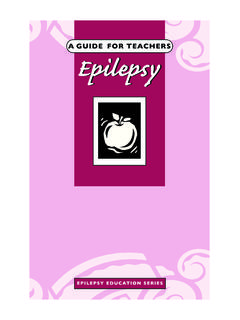Transcription of Quick Guide on Processing Jerky - HACCP Alliance
1 Updated Compliance Guideline April 2007 Quick Guide on Processing Jerky and Compliance Guideline for Meat and Poultry Jerky Produced by Small and Very Small Plants Updated Compliance Guideline April 2007 Compliance Guideline for Meat and Poultry Jerky Produced by Small and Very Small Plants 2 Quick Guide on Processing Jerky The Compliance Guideline for Meat and Poultry Jerky lists seven (7) Processing steps in the production of meat and poultry Jerky where some level of microbial intervention can be applied to maximize lethality. While it may not be necessary for some establishments to apply all seven of these steps, the lethality treatment and drying steps must be used in all processes to ensure that a safe product is produced. Lethality treatment: For meat Jerky , use of the time-temperature combinations provided in the lethality compliance guidelines (Appendix A of the final rule Performance Standards for the Production of Certain Meat and Poultry Products ; ) can be used to ensure the safety of the product.
2 For poultry Jerky , the minimum internal temperatures listed in the lethality compliance guidelines of 160 F for uncured poultry (see complete Compliance Guideline regarding 155 F for cured and smoked poultry) can be used to achieve an adequate lethality. The time-temperature combinations listed in the Time-Temperature Tables For Cooking Ready-To-Eat Poultry Products can also be used for lethality. The 90% humidity parameter must be applied throughout the lethality treatment for meat and poultry Jerky if the lethality compliance guidelines (Appendix A) are used as supporting documentation. The humidity must be maintained at 90% for the time that the product is heated at the temperature specified in Appendix A. Some simple and practical measures that can be used to aid in meeting the humidity parameters in the lethality compliance guidelines include: Sealing the oven dampers to provide a closed system and to prevent moisture loss.
3 Adding humidity to the system by placing one or more shallow, wide pans of water in the oven or by injecting steam in the oven. The establishment is expected to measure and maintain the relative humidity during the lethality treatment. The process should be monitored using wet and dry bulb thermometers. The use of wet and dry bulb measurements can be used to determine relative humidity ( ). Drying: After the lethality treatment, the product is dried to meet a water activity level that will stabilize the finished product for food safety purposes. A water activity critical limit for stabilization of or lower should control growth of all bacterial pathogens of concern. The finished product must also meet the moisture protein ration (MPR) product standard. Updated Compliance Guideline April 2007 Compliance Guideline for Meat and Poultry Jerky Produced by Small and Very Small Plants 3 Compliance Guideline for Meat and Poultry Jerky Produced by Small and Very Small Plants Purpose This document is intended to provide updated guidance and information for the small and very small meat and poultry plants that manufacture Jerky .
4 It is not intended to set any regulatory requirements. Background Meat or poultry Jerky is a ready-to-eat (RTE), dried product that is generally considered to be shelf-stable ( , it does not require refrigeration after proper Processing ). In the early fall of 2003, FSIS found that producers of meat and poultry Jerky may not be adequately Processing Jerky to achieve the lethality necessary to produce a safe product. FSIS identified two points in Jerky Processing where producers need to improve. 1. Ensuring an adequate lethality If the requirement for moist cooking is not achieved, heat treatment alone may not be enough to meet the lethality performance standards. Processors that use dry heat to both heat and dry their product will not achieve adequate lethality during the heating process because the product dries prematurely, and the lethality process stops.
5 Buege et al. (2006) and Faith et al. (1998) demonstrated that this failure would occur through studies in which an adequate lethality was not achieved by a slow temperature rise or by a long time at sub-lethal temperatures. 2. Using water activity and not Moisture Protein Ratio (MPR) FSIS is aware that some manufacturers rely upon the maximum moisture protein ratio (MPR), rather than water activity, for determining whether their process adequately dries the Jerky to produce a shelf-stable product. Water activity, however, as measured by laboratory analysis, is the more appropriate indicator to verify that the Jerky is properly dried. Water activity is a better measure of available water for microbial growth than MPR. Minimizing available water ( , achieving a water activity of or less) is critical for controlling the growth of pathogens.
6 However, an MPR of :1 or less remains part of the standard of identity for Jerky . Thus, an MPR of :1 or less is necessary to call the product Jerky , but it is not sufficient to ensure a safe product. Definition of Lethality treatment: The process step or steps used to destroy pathogenic microorganisms on or in a product to make the product safe for human consumption. Updated Compliance Guideline April 2007 Compliance Guideline for Meat and Poultry Jerky Produced by Small and Very Small Plants 4 Lethality Compliance Guidelines for Jerky In general, Jerky Processing includes slicing or forming the meat or poultry, marinating, heating, and then drying the strips. The purpose of the heating step is to apply a lethality treatment to kill or reduce the numbers of microorganisms.
7 Drying the Jerky stabilizes the final product and prevents the growth of microorganisms, especially toxigenic microorganisms such as Staphylococcus aureus. Some processors combine the heating and drying procedures into one step. However, it is critical that the heating step includes adequate humidity before the Jerky is dried. If the times and temperatures in the lethality compliance guidelines (Appendix A of the final rule Performance Standards for the Production of Certain Meat and Poultry Products ; ) are used, it is critical that the humidity criteria be rigorously followed during the cooking/heating (lethality) steps. Note: Appendix A was developed for large mass meat products, not thin strips of meat. The humidity parameters in Appendix A cannot be maintained in a home-style dehydrator.
8 However, processes that can achieve an adequate reduction of Salmonella and E. coli O157:H7 in dehydrators are described in the studies by Buege et al. (2006), and Harrison et al. (2006). The following are general or common Processing steps used in Jerky production. Although an establishment s process may not include all these steps, the lethality treatment and drying must be utilized to produce a safe product. The intervention step may be required for those processes that do not achieve an adequate lethality. The steps listed as heating and drying are consecutive steps. Drying should closely follow heating. Heating is used to achieve lethality of harmful microorganisms, and drying is used to stabilize the product. Step 1 - Strip preparation: Whole muscle is sliced or ground; ground product is formed into strips.
9 (Some Jerky is formed.) Step 2 Marination: The strips are then marinated in a solution that often contains salt, sugar, and flavoring ingredients. Step 3 - Interventions: Antimicrobial interventions, before and after marinating the strips of raw product, have been shown to increase the level of pathogen reduction beyond that achieved by heating alone. Some heating processes may not deliver an adequate lethality and, thus, may require an additional intervention step to ensure product safety. Examples of such interventions are: Preheating the meat or poultry Jerky strips in the marinade to a minimum internal temperature of 160 F will provide an immediate reduction of Salmonella (Harrison Updated Compliance Guideline April 2007 Compliance Guideline for Meat and Poultry Jerky Produced by Small and Very Small Plants 5and Harrison, 1996).
10 Heating in the marinade may produce an unacceptable flavor for some products; however, other liquids such as water could be used. The times and temperatures in the lethality compliance guidelines could be used for preheating in the liquid. Dipping the product in 5 % acetic acid for 10 minutes before placing it in the marinade can augment the log reduction effects of drying but not enough to eliminate pathogens (Calicioglu, 2002 & 2003). This intervention may also result in an undesirable flavor. Dipping the product in 1:2 or 1:3 mixtures of calcium sulfate (Mionix Safe2O ) and water for 30 seconds can increase the level of reduction of Salmonella, Listeria monocytogenes, and Escherichia coli O157:H7 above that achieved with no pretreatment. Pretreatment with acidified sodium chlorite (Keeper ) at concentrations between 500 and 1,200 ppm also was effective.
